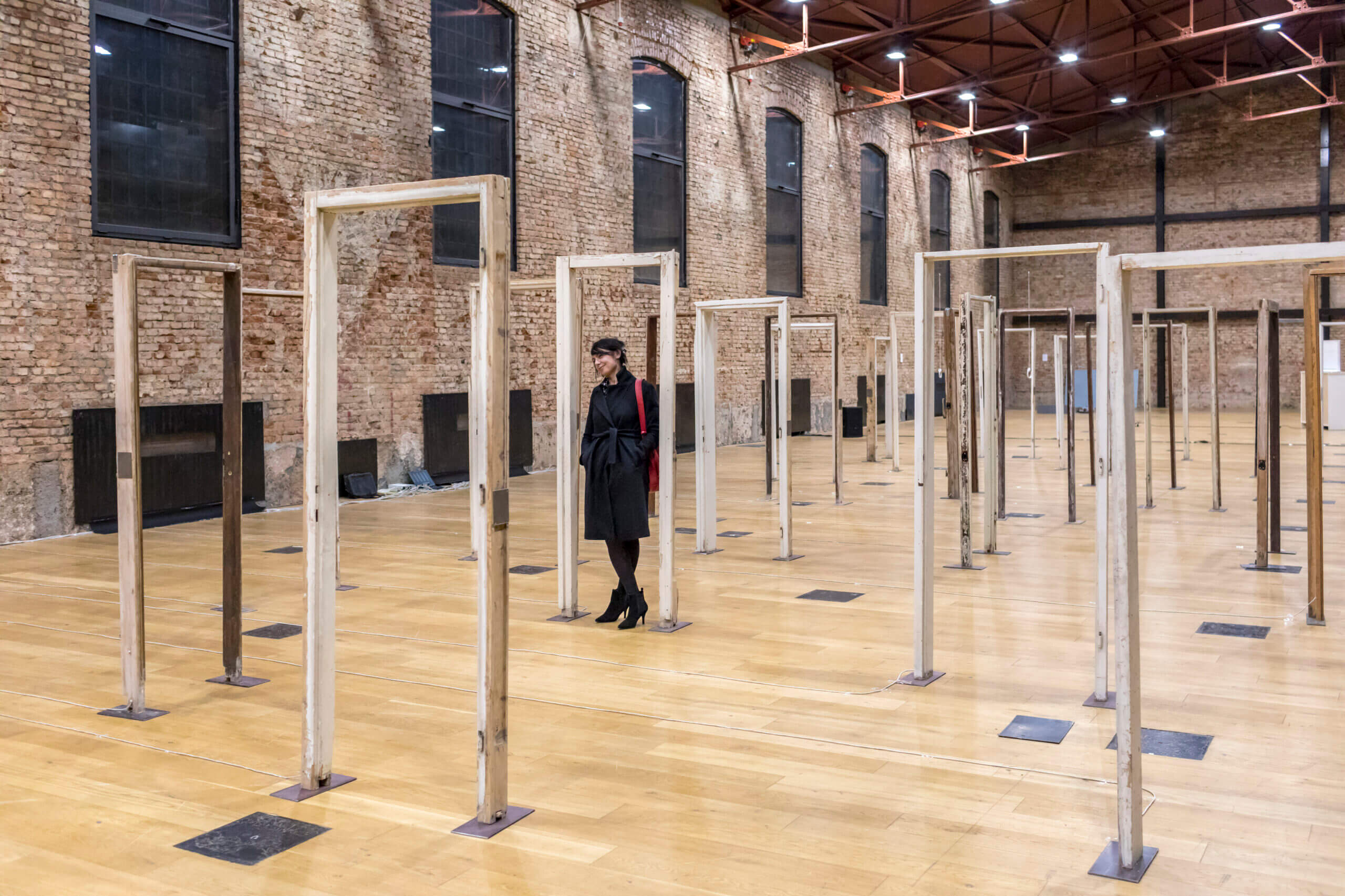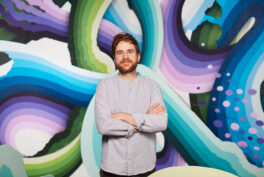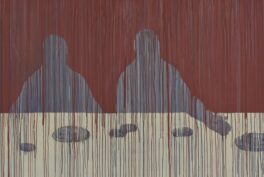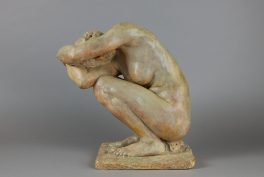Summary
- Visitors play an essential role in the art world of Marijana Stanić.
- Limitations of the exhibition place can make old artworks look different.
- Obstacles that Marijana Stanić faces.
- Distribution and storage issues that an artist has to deal with.
Sociologist Howard S. Becker, in his book Art Worlds (published in 1982), explores the cooperative network of different people working with an artist (suppliers, distributors, performers, other artists, critics, and audience). He holds the opinion that they form the art world altogether, a world of individuals who contribute to the creation of art. He further analyzes how these art worlds, each with its conventions, affect the works that are created and explain how they function. When creating their works of art, artists use material resources and collaborate with people of different professions, depending on the medium and the type of artwork. The available resources make things possible, but some are easy and some are more difficult to reach.
Recently, I saw the interactive exhibition Passages, which took place in the Lauba Gallery, House for People and Art in Zagreb, Croatia, and had the privilege to talk to the artist Marijana Stanić whose works were on display. The exhibition included her artworks created over the past 20 years. We talked about some topics addressed in Becker’s book.
Stanić was born in 1971 in Zagreb. She graduated from the Academy of Fine Arts in Zagreb. She is also the director and the curator of Gallery 90-60-90 / Pogon Jedinstvo. In her work, she uses various materials and media such as drawing, audio, multimedia installations, radio drama, found objects, and art games. The problematization of modern values and consumerism is characteristic of her approach to art.
Collective Activity
PD: The creation of every artwork requires resources. You are a conceptual and multimedia artist. Do you consider your works a result of collective action or do you see yourself as the only author of the work? For example, in your artwork – Sweet Life, three performers, figures of brides-like dolls, act in a three-hour seance. The choreography is discrete, their eyes are closed or staring into space. There is no boundary between the space of the spectators and the performers. The viewers are pulled into the intimate space of the girls and become voyeurs. What are the roles of the performers and the viewers in this work? Do they, along with the artist; “produce” this art piece? To what extent does this collective activity shape your art?
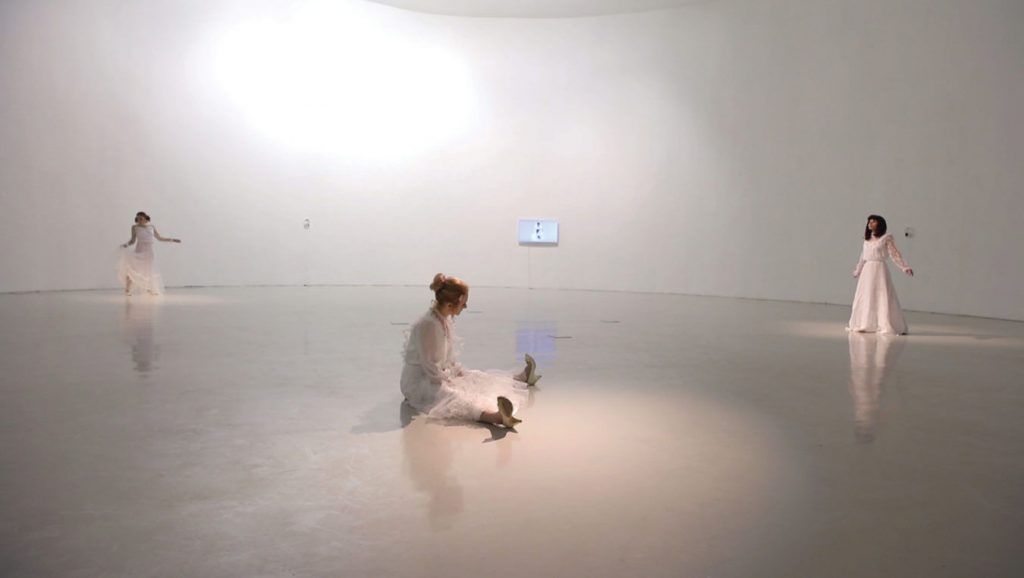
Marijana Stanić, performance for the closing of the exhibition Sweet Life, 2019. Gloria.
MS: Through this exhibition, which brought together nine of my works created over the past 20 years, it was interesting to put them together and look at them from a new perspective. How they communicate with each other and how I communicate with them as an artist. The new installation, Passages, was made for this exhibition but placed together with all the other works, key moments, or strategies in my oeuvre can be seen. One of them is very visible in this exhibition – all my works very actively involve the visitor and their movement. It is very important for my work to get activated.
In the work Sweet Life, I included other people, in this case, performers, for the first time. So, my work is not about objects and installations, it’s about performance. The performers are placed in the space almost as objects because they are motionless and static. The visitor, on the other hand, is active and part of the work by asking themselves questions about their attitude towards the performers. For example, some visitors loudly wondered if the performers were really alive, which is, among other things, the point of the artwork – to emphasize the objectivity of women and their role. That is why in the original work, it is important that the audience circulates, and walks around the performers.
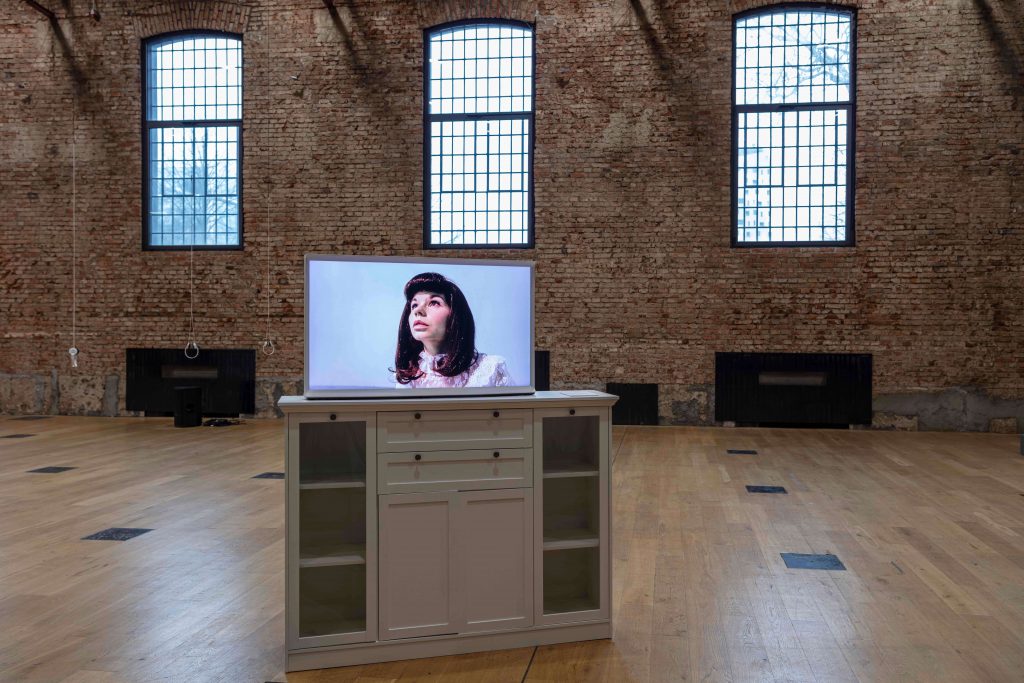
Marijana Stanić, Sweet Life, 2022, Lauba House for People in Art, Zagreb, Croatia. Photograph by Jasenko Rasol.
In this exhibition in Lauba, since the performance is presented as documentation of the original work, the visitor gets a new role and is placed in front of the screen. They watch both the performers and the audience in the video, so the immovability of the performer is even more emphasized in relation to the movability of the visitors around them. I paid special attention to the exhibition setup of the works, which are actually the documentation of my earlier works.
So, for this occasion, the documentation of the performance Sweet Life, whose image is dominated by the dazzling whiteness of wedding dresses, can be seen on a white TV placed on a white chest of drawers (in the role of a pedestal, but also a symbol of home). In this way, this work became a new installation. The audience and their mingling are an integral part of all the exhibited works: in Passages, the visitor’s movement activates the installation; in Birdhouses the one looks for a spyhole in which to peek; Quail is a small bird but knocks down the horse and the hero, you should get really close to the work to actually see it; to see Balcony one should look up high… The mobility of guests is very important for my art.
Constraints and New Opportunities
PD: Your audio installation Happy Endings had several versions. It was created by merging the final sentences of fairy tales and focusing on the phrases about eternal happiness in love, which exposed us to stereotypical thinking. Originally it was an audio work played on Croatian Radio, later it was exhibited as an ambient installation in a big dark gallery filled with children’s voices. Now you had to adapt it to this exhibition space, which could not be dark, so the impression of powerlessness in space from the previous exhibition space was missing. How did this affect the work itself? Does it become a new piece of work with every change? Does it convey another message, sensibility, or impression? How do you feel about adapting the original work to the exhibition space?
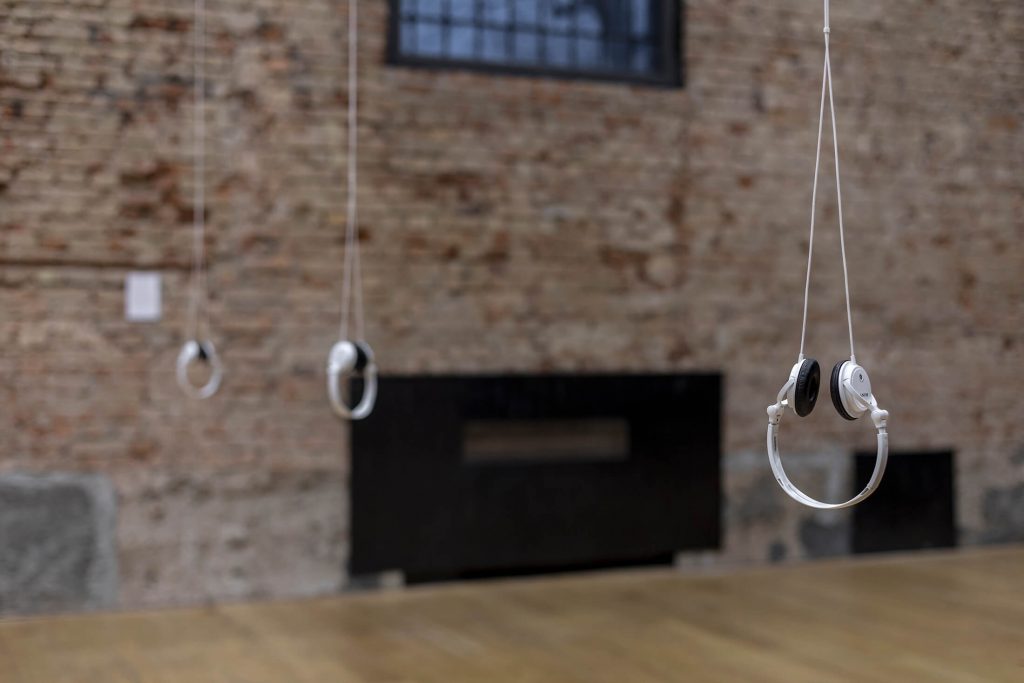
Marijana Stanić, Happy Endings, 2022, Lauba House for People in Art, Zagreb, Croatia. Photograph by Boris Cvjetanović.
MS: Since this exhibition in Lauba is a mini-retrospective, the new work Passages is located in the middle of the exhibition room and other works are placed depending on the context of their creation. The selection of works was made by the curator Irena Bekić. Happy Endings fits perfectly with Sweet Life as their subjects are similar, they build on and underline the theme.
However, there was definitely no room here to present Happy Endings in the original version, which certainly contributes to the very idea and the work itself. So, we can say that a disorienting experience of a visitor in a dark room is missing here. They felt lost because children’s voices came unpredictably from different directions in a completely darkened gallery space and were perhaps associated with the subconscious which was talking to them. However, this work can function well in this way, too. Here the headphones are hanging in the space, so the visitor actually stumbles upon them when walking through the space. The headphones do not just hang on the wall to serve the documentation of the work, but build a visual impression, hovering in a large exhibition space, and arise curiosity.
This work has thus become a new installation. Given that this piece was set in the context along with other artworks, on one hand, it was necessary to take care of these works to not bother each other and on the other hand, I wanted to get the most out of them again. I can say that I am pleased with the way we have incorporated this work into the new exhibition.
Realization of an Idea
PD: When you start to develop an idea for your new work do you usually think of the needed resources, like art materials, equipment, the assistance of professionals of other professions, and budget in parallel? For example, for your luminist kinetic installation – Quail is a small bird but knocks down the horse and the hero you needed specific toys that should be connected to electromotors. When did you actually start thinking about where and how can you obtain the objects and whether you knew somebody who would want to work with you on that installation? And of course, how much would it cost?
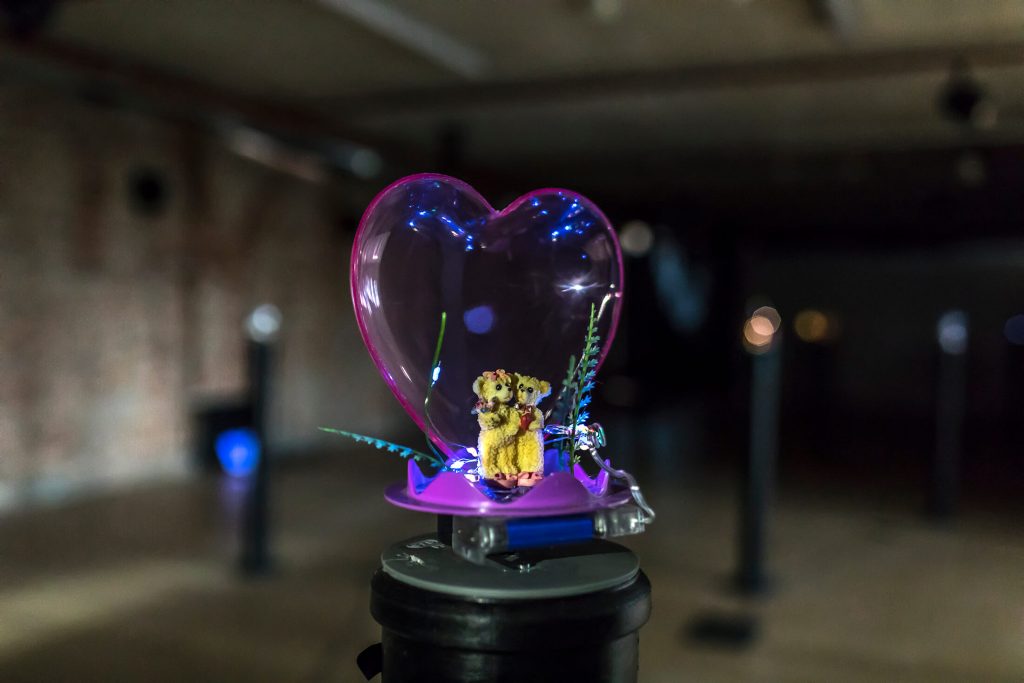
Marijana Stanić, Quail is a small bird but knocks down the horse and the hero, 2004, Lauba House for People in Art, Zagreb, Croatia. Photograph by Boris Cvjetanović.
MS: Most probably artists would not be artists if they thought about all this in advance, because then many things would not even start, as they would very quickly come to the conclusion that the realization is impossible. Since I am a multimedia artist, all my works, no matter how thematically connected; were created very differently. I always start with an idea.
How I realize some work depends on the idea I imagined. These are all very exciting and interesting processes. In fact, the process of creating the artwork is perhaps the most beautiful. Quail is a small bird but knocks down the horse and the hero is the oldest work in the exhibition. It is ready-made. I was surrounded by toys back then and fascinated by the products of small haberdashery, kitsch, and pop culture. Beautiful, but at the same time frightening, they speak about the society in which we live.
Anyway, first an idea comes up and then I start digging, I don’t think about obstacles. I consider this to be the task of the artist. To be inventive in solving problems because these are not products that one can buy in a store, the artist must explore the way they will create them.
For example, for this installation, I first imagined that objects are small, rotating, and bright. I needed electric motors, which I found through ads. These were actually the parts that served to make the washing machine work. The pipes on which they stand are plumbing pipes, so they are practical, as the wires can pass through them, and in fact very cheap. Installation as a medium is the most complex and expensive medium in art. For me personally, both as an artist and as a curator, it is the most attractive and exciting medium, but it is the most demanding both to create and to exhibit and later to store.
PD: For your recent work Passages, an interactive audio installation, you needed 28 discarded door frames. The sound of a slammed door is activated by passing through those door frames. When creating such works, you usually think of the predictable difficulties that follow. But there are certainly unpredictable ones. Did you ever have to give up your idea because some types of materials or persons with certain skills, professional or non-professional people, were not available, or were just too expensive?
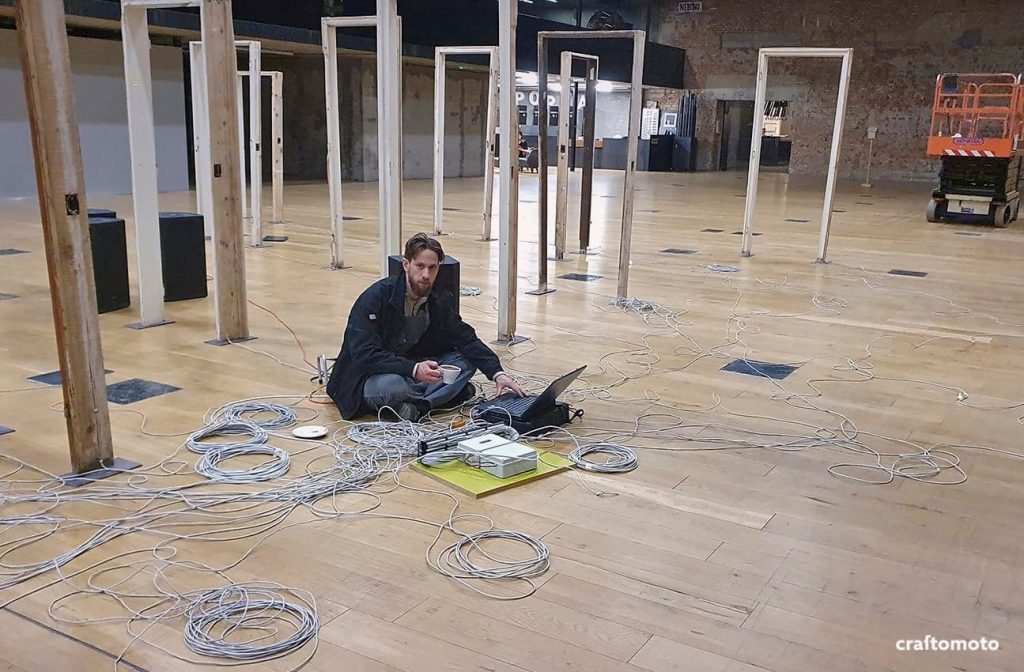
Vedran Relja working on Marijana Stanić’s installation Passages, 2022, Lauba House for People in Art, Zagreb, Croatia. Vedran Relja’s Facebook page.
MS: I mostly don’t give up on an idea. What could stop me is finance. It can also happen that for financial reasons the idea “narrows” in some way. Indeed, obstacles can be very unexpected. For example, when I was working on my latest work Passages, I thought it wasn’t that complicated.
Namely, I needed door stocks. A lot of buildings are being demolished in the city these days, I didn’t consider finding them to be a problem. But it turned out that the door frames on the bulk waste are broken and unusable. Then through ads, I started looking for workers who are demolishing apartments and I negotiated with them and paid them especially to be careful when removing door stocks not to damage them.
The workers had to be motivated somehow. Then I had to arrange the transportation of these door frames. The next step was to give them sound. For that, I needed software and someone who would technically design it. Even that wasn’t easy and from the original idea of 50 stocks, I came up with 28 realized, and none of the people I knew, who deal with such media, could offer me a solution for the sound part of the installation.
Finally, Vedran Relja, who has a company dealing with special projects, offered the solution. Sound-driven sensors are custom garage door sensors. But in today’s crisis, getting 50 sensors in the short term was challenging. Also, invisible sound sensors require 1000 meters of cable and special software to trigger sounds. The sensor moved a key on the keyboard, each was marked with a different sound. Thus, in the end, the number of stocks was limited by the number of keys on the keyboard. The connection between the ruined discarded door frames and intermittent sensors and custom software is interesting – namely, discarded door stocks thus became a technological device.
PD: You are not only an artist but also a curator. What are the most common obstacles that you face when organizing exhibitions for other artists?
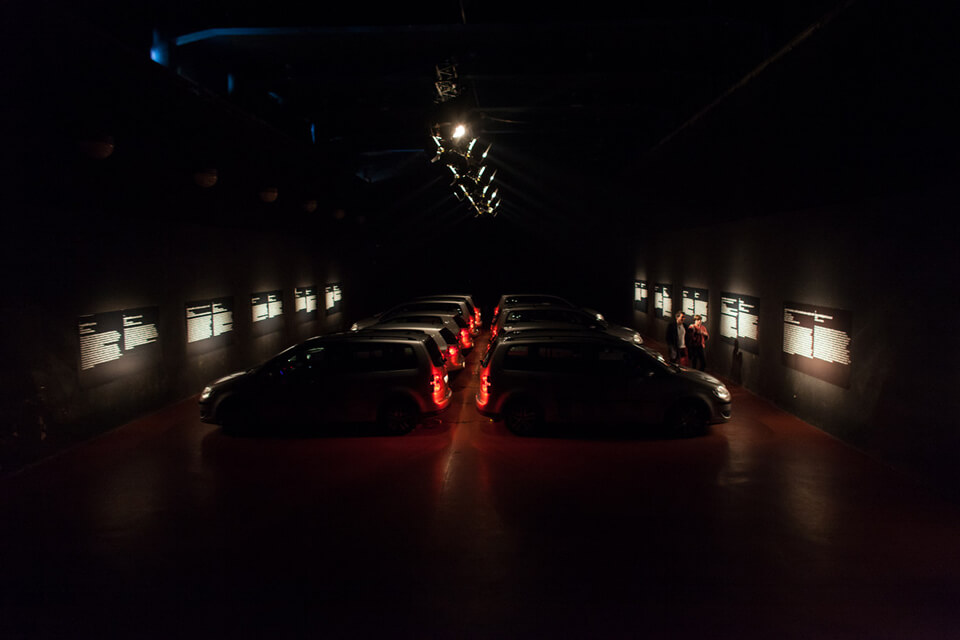
Exhibition Picture of sound, 2011, Gallery 90-60-90, Zagreb, Croatia.
MS: The most common obstacles are financial. As I am a curator in the non-profit independent sector, we are funded exclusively by sponsors and donors, most often city and state institutions, and more recently EU funds. However, the funds are still insufficient for everyone to be paid for their work in the organization and preparation of the exhibition, so the organizer and the artist often volunteer.
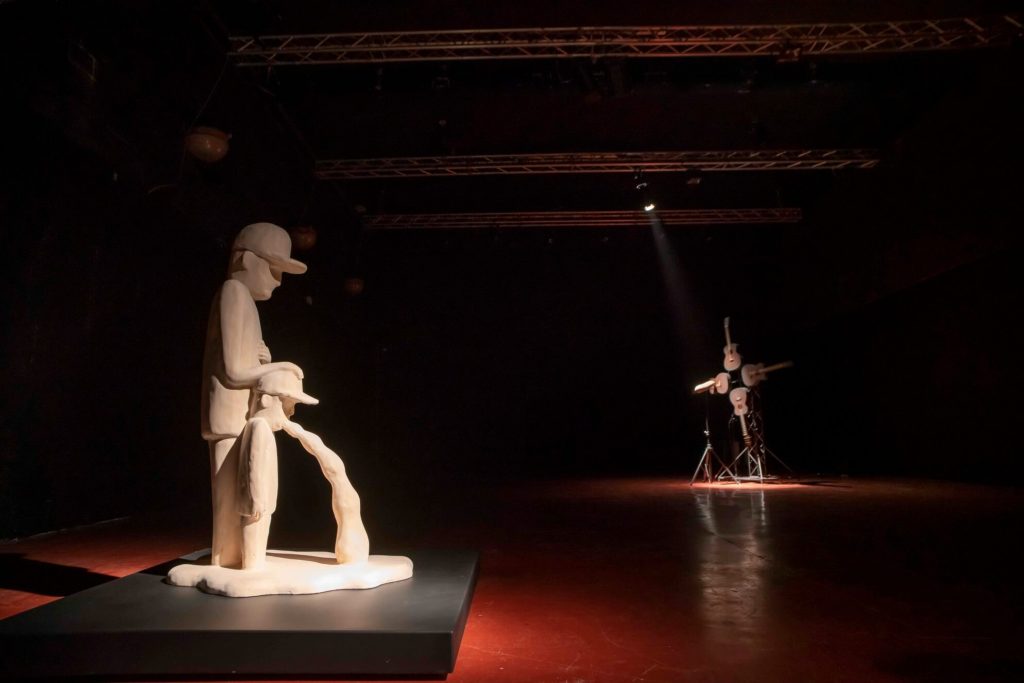
Igor Ruf, from the exhibition Acoustic turbo sonic momentum, 2022, Gallery 90-60-90, Zagreb, Croatia. Photograph by Jasenko Rasol.
Distribution and Storage
PD: Once they have completed their work, the artists need to distribute it and make up for the invested time, money, and material. The big problem of the art world, according to Becker, is how to organize an artwork so that people can make a living from it. Many artists never make any money from their work and cannot finance further work with the income from what they have already created. For example, your work Balloons exists as a video. It was made as a part of the project Environment of Memory – Art Against Repression and filmed on the island Goli Otok, the former labor camp for persons accused as spies of the Eastern Bloc, later a prison, and today completely forgotten. But videos and other installations are not something you could really sell and live from it, isn’t it? Do you manage to live from your art?
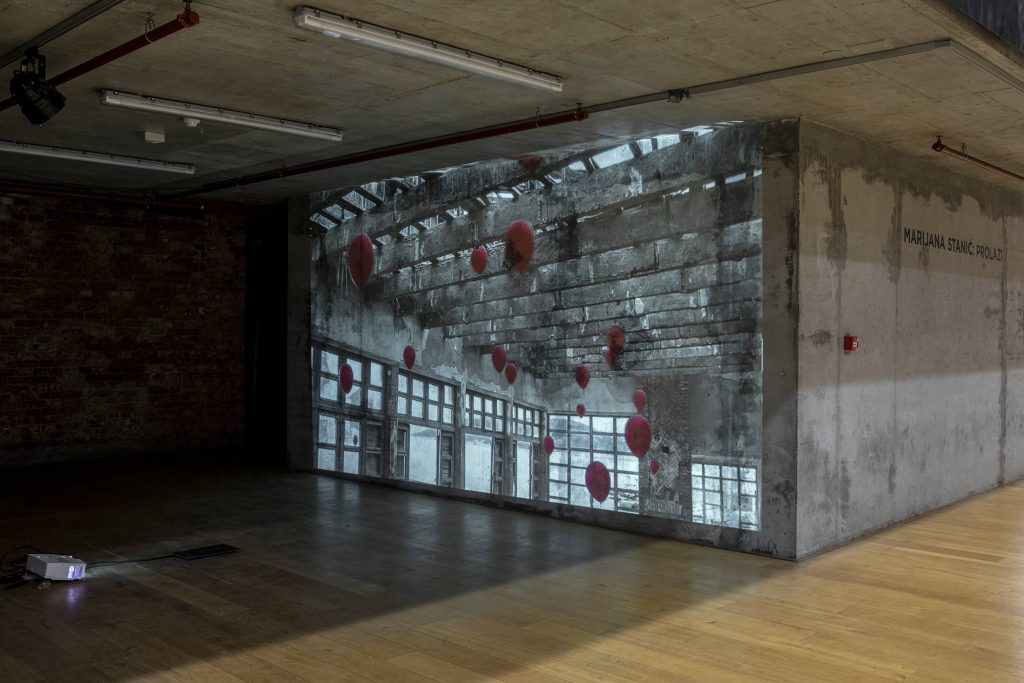
Marijana Stanić, Balloons, 2018. Photograph by Boris Cvjetanović.
MS: It is definitely difficult to be an independent artist and make a living from it. So, we are always more or less forced to do other things which then prevent us from realizing artistic ideas and work. It often turns into a kind of “waiting for a better time.” Therefore, it is important, as in everything, to have continuity. It is necessary for an artist to stay on the scene and to stay in “artistic condition”. The type of work that I’m creating is very difficult to sell.
PD: Your work Balcony was recently purchased by this gallery. This poetic and fairytale object is in strong contrast to the cold, large and raw space of the gallery. Romantic and isolated, it found its place in the middle of huge brick walls, so you also don’t have to think about its storage anymore. But what do you do with your other works after an exhibition? For example, your recent work Passages requires a big storage place for 28 door frames. There are also digital sensors and collecting interfaces that should be stored with great care due to their delicacy.
The same goes for your work Birdhouses. Six wooden birdhouses contain video projections of various sky shots. Small, dark, hidden, cramped space offers a view of the open sky. These projections are visible through lenses on the front sides of the birdhouses. You mainly produce works that make visitors look, listen and move. But where do you store all your complex audio-visual installations after the exhibitions?
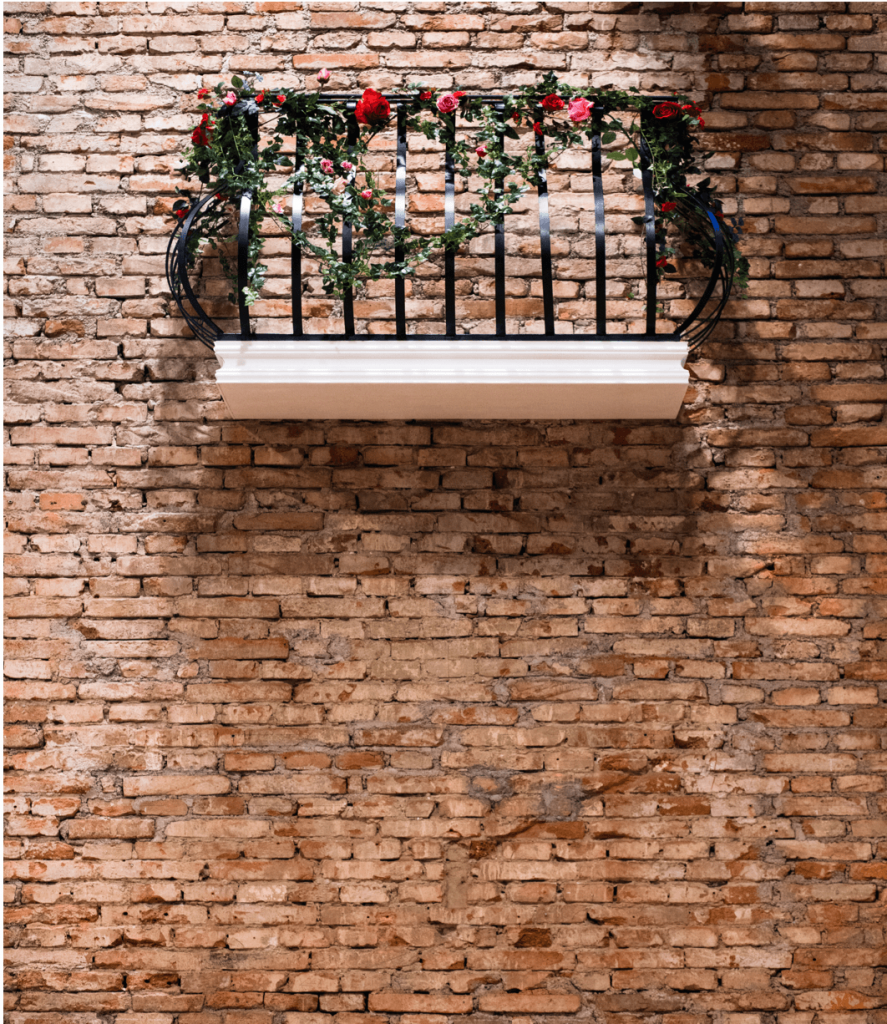
Marijana Stanić, Balcony, 2007. Photograph by Ivan Idžojtić. Vizkultura.
MS: That really is a big problem. But if you are already an artist and you have this need to create, as you do not think too much about how you will realize your idea, or how you will finance it, you also don’t think in advance about what you will do with it later. Although, it is a real problem. Ideally, most of the artworks would end up in museums and galleries, like the Balcony. If this happened, I would be the happiest. These works are not for domestic use. Therefore, I hope that in the future they will find their place and will be available to the audience for which they were made because that would essentially prolong their lives in the true sense of the word. Until then, fortunately, I have a large attic and a large basement, and I somehow manage there.
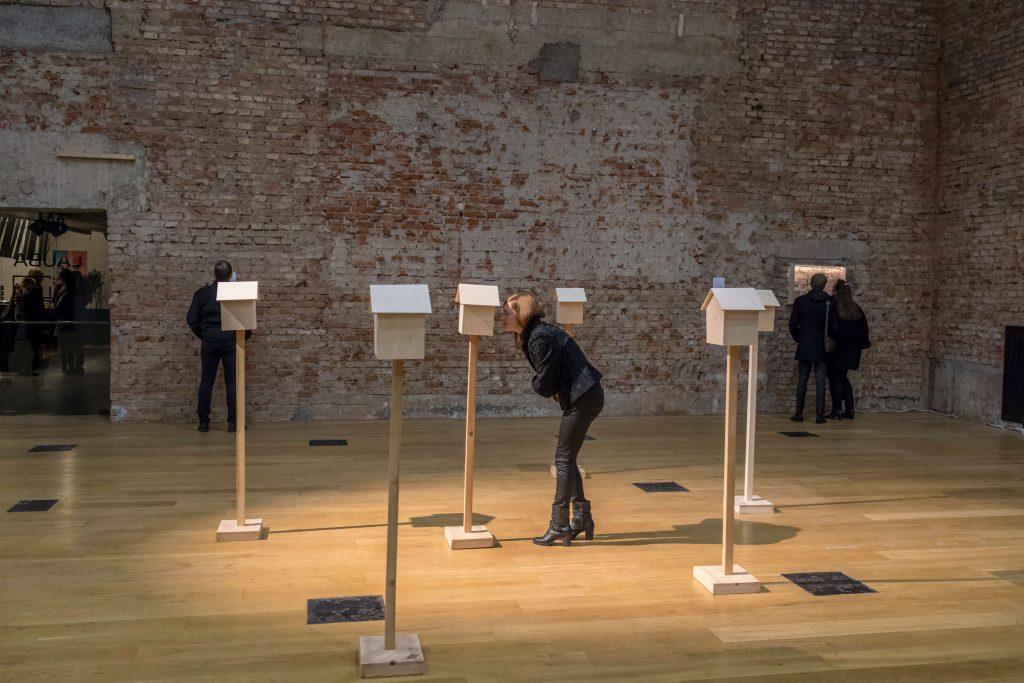
Marijana Stanić, Birdhouses, 2008. Photograph by Boris Cvjetanović.
PD: This exhibition took a lot of your energy but are there any exciting upcoming projects that you already have in mind as an artist or as a curator?
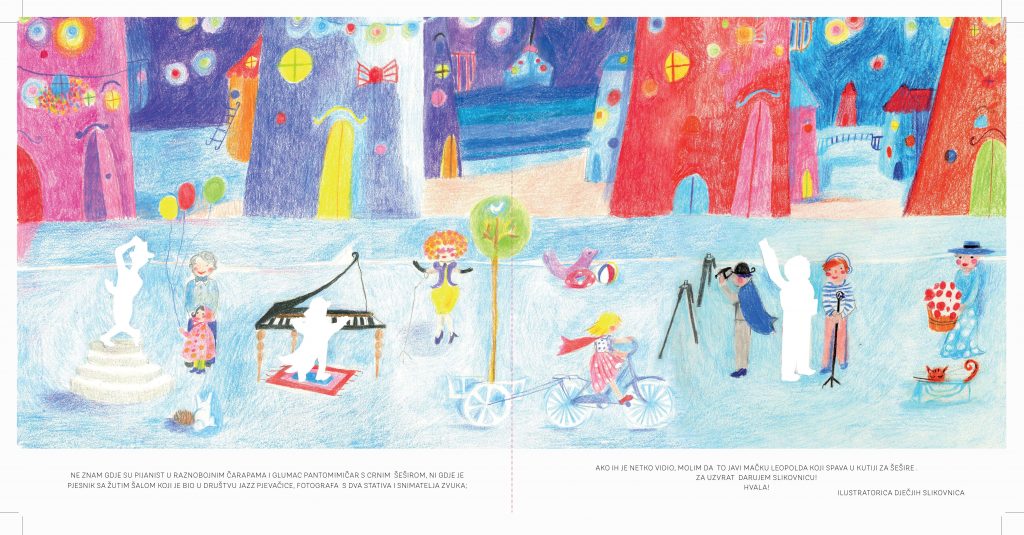
Marijana Stanić, Irena Bekić, picture book. Courtesy of the artist.
MS: Of course, projects are never lacking. In Gallery 90-60-90 / Pogon Jedinstvo, we will exhibit interesting local multimedia artists. Also, as a gallery, we participate in the Boutique Art Fair NESVRSTANI, an art fair that presents independent artists and art organizations, where we will present several young artists. As for my projects, I am happy that my work Passages will be exhibited at the XIV Triennial of Croatian Sculpture in Zagreb. I am also preparing our second picture book for children with Irena Bekić. The topic is very interesting and educational. It deals with artistic occupations that children get to know in an interesting and creative way.
Many thanks to Marijana Stanić for having this nice and inspiring talk with us!
